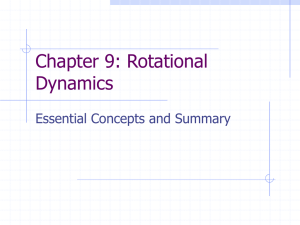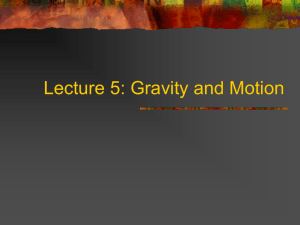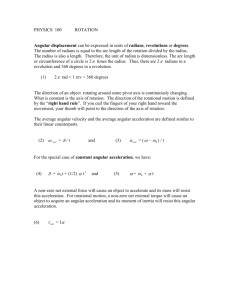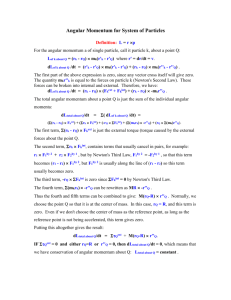Angular Momentum Study Guide - Physics I
advertisement
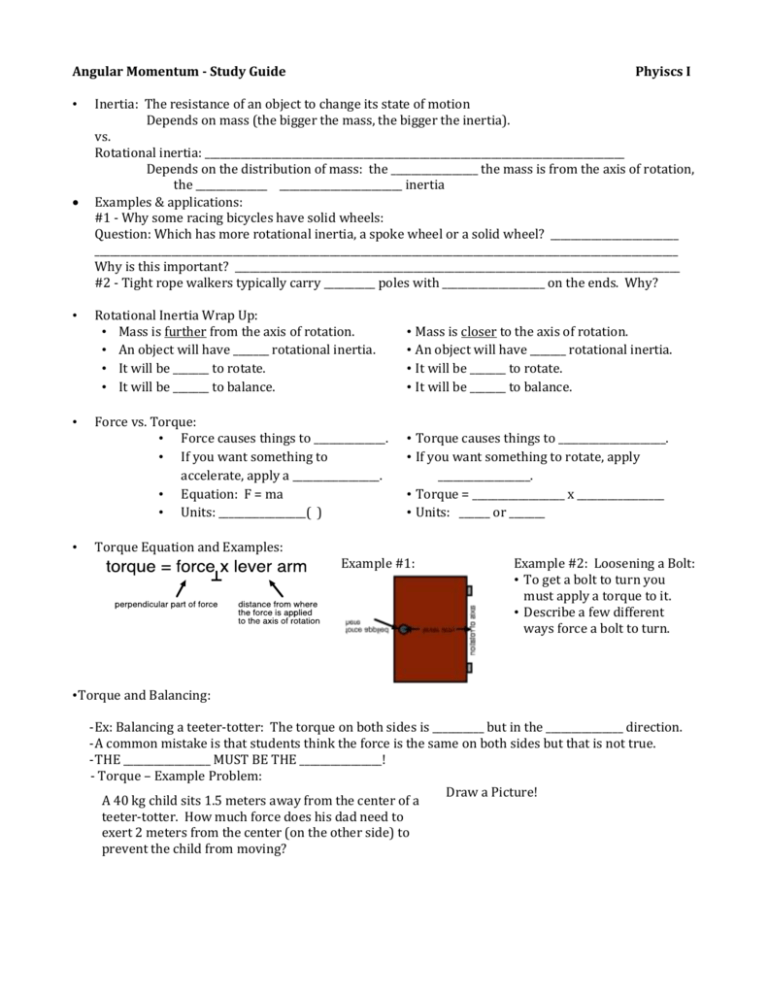
Angular Momentum - Study Guide • • • • Phyiscs I Inertia: The resistance of an object to change its state of motion Depends on mass (the bigger the mass, the bigger the inertia). vs. Rotational inertia: __________________________________________________________________________________ Depends on the distribution of mass: the _________________ the mass is from the axis of rotation, the ______________ ________________________ inertia Examples & applications: #1 - Why some racing bicycles have solid wheels: Question: Which has more rotational inertia, a spoke wheel or a solid wheel? _________________________ __________________________________________________________________________________________________________________ Why is this important? _______________________________________________________________________________________ #2 - Tight rope walkers typically carry __________ poles with ____________________ on the ends. Why? Rotational Inertia Wrap Up: • Mass is further from the axis of rotation. • An object will have _______ rotational inertia. • It will be _______ to rotate. • It will be _______ to balance. • Mass is closer to the axis of rotation. • An object will have _______ rotational inertia. • It will be _______ to rotate. • It will be _______ to balance. Force vs. Torque: • Force causes things to ______________. • If you want something to accelerate, apply a _________________. • Equation: F = ma • Units: _________________( ) • Torque causes things to _____________________. • If you want something to rotate, apply __________________. • Torque = __________________ x _________________ • Units: ______ or _______ Torque Equation and Examples: Example #1: Example #2: Loosening a Bolt: • To get a bolt to turn you must apply a torque to it. • Describe a few different ways force a bolt to turn. • Torque and Balancing: - Ex: Balancing a teeter-totter: The torque on both sides is __________ but in the _______________ direction. - A common mistake is that students think the force is the same on both sides but that is not true. - THE _________________ MUST BE THE ________________! - Torque – Example Problem: Draw a Picture! A 40 kg child sits 1.5 meters away from the center of a teeter-totter. How much force does his dad need to exert 2 meters from the center (on the other side) to prevent the child from moving? • Angular and Linear Momentum Compared and the Conservation of Angular Momentum: Linear Momentum = mass x velocity ( p = mv ) Angular Momentum = rotational inertia x angular speed (L = Iw) • Conservation of Angular Momentum Question: Why do ice skaters spin so much faster when they bring their arms close to their bodies? Law of Conservation of Angular Momentum: ___________________________________ ___________________________________ ___________________________________ ___________________________________ ___________________________________ ___________________________________ ___________________________________ Vector Quantity: Angular Momentum Before = Angular Momentum After Rot. Inertia x Rot. Velocity = Rot. Inertia x Rot. Velocity (before) (after) Equation Form: Ii wi = If wf _________________________________________ ______________ Momentum, like ______________ momentum is a ______________ Direction of Angular Momentum: Because the direction of something rotating is hard to determine, physicists say that the direction of angular momentum is in the What does that mean? ______________ is ________________! plane of the rotation. Example Problems: #1: Torque: What is the torque on a bolt if you are pulling with a force of 200 N directed perpendicular to a wrench of length 25 cm? How does the torque change for a wrench of twice the length? #2: Seesaw problem: Dumbo and Mickey Mouse are on a seesaw as shown in the picture to the right. Dumbo weighs 1,000N. Mickey Mouse weighs 1N. If Dumbo is 1 m from the seesaw’s pivot point, how far from the pivot point would Mickey Mouse have to be for the seesaw to be balanced? a. b. c. d. 1m 10m 100m 1000m _____________ _____________ _____________ _____________ Direction Example: Name: _____________________________________________________ Period: ________ Date: ____________________________ Test Review Problems: Momentum, Impulses, and Conservation of Linear Momentum Instructions: Answer the following questions. PSWY (Please Show Your Work). For the collision problems, you must draw a ‘before’ and ‘after’ picture. 1. What is the relationship between impulse and momentum in words? As an equation? 2. You kick a soccer ball with a force of 40 N. Using high speed photography, it is determined that the ball and your foot were in contact for 0.6 seconds. What impulse is delivered to the ball? 3. Find the momentum of a 20 kg ball rolling to the right, across a table at 2 m/s. a. p=? b. If the ball hits another ball and as a result, slows down to 1 m/s, where did that missing momentum go? c. What is the impulse that the 20 kg ball receives? d. What is the impulse that the second ball receives? 4. A 70 kg bumper boat runs into a 50 kg bumper boat at the Berlin Batting Cages. If the 70 kg boat was initially moving at 2 m/s, and the 50 kg boat was at rest, what must be the final speed of the 50 kg boat if the 70 kg boat is slowed to 1 m/s? 5. A 2000 kg compact car moving at 6 m/s runs into a 4000 kg pickup truck which was at rest. a. If the compact car slows down to 2 m/s, what impulse did the car receive? b. What impulse was delivered to the pickup? c. What will be the new speed of the pickup? d. Did these two vehicles bounce off each other? 6. You are fixing your car and your little sister is watching. Your sister watches as you struggle to lossen a bolt from the engine. What is the torque on a bolt if you are pulling with a force of 150 N directed perpendicular to a wrench of length 15 cm? Your little sister get’s a pipe to place over the handle of the wrench which extends the handle length to 45 cm. How does the torque change?






